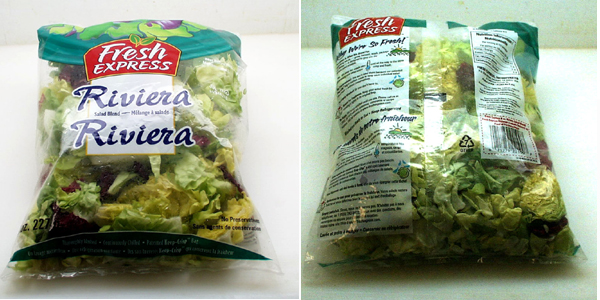Course:FNH200/Lessons/Lesson 07/Page 07.2
7.2 Refrigeration (Cool Storage) of Foods
Refrigeration is one of the mildest approaches to food preservation.
- Refrigeration/Cool storage of foods falls between -2°C to 16°C. However, in the food industry, the refrigeration temperatures should be in the range of 4°C and below. The Food and Drug Regulations of Canada state that perishable foods that can support the growth of disease-causing microorganisms must be stored at temperatures of 4°C and below.
- A drop of 10°C slows down rate of senescence by 2 to 3 times and microbial growth by 3 to 6 times.
- Refrigeration temperatures inhibit the growth of most disease-causing microorganisms but can favour the psychrotrophic microorganisms.
- Some spoilage-causing microorganisms, particularly moulds, can grow at temperatures as low as -8°C.
- You must keep in mind that refrigeration storage temperatures only provides a short term extension to the storage life of foods
- Refrigeration storage of foods can not improve the quality of a food item that is low of quality when placed into cold storage.
In addition to being a mild approach to short-term preservation, refrigeration is also sometimes applied to achieve desirable attributes of fermented food products such as cheeses, beef and wine upon cool ripening or aging.
What are the optimal conditions for refrigerated storage of foods?
Each food commodity has its optimum refrigeration conditions for maximum storage life and retention of quality and nutritional value.
The storage life of meats, fish and dairy products are maximized by temperatures that approach 0°C. During refrigerated storage of foods, maintenance of controlled temperatures are very important to ensure maximum storage life of the foods and to prevent chill injury to certain foods, especially some fruits and vegetables. For example, as reported by Potter and Hotchkiss (1995):
- Bananas will undergo a colour change in the peel from yellow to black, while sweet potatoes may show decay, pitting and internal discolorations, when stored at temperatures below 13°C.
- Apples may become soggy or show internal browning if stored below 1-2°C.
- Potatoes and avocados may also become brown if stored below 5 and 7°C, respectively.
Other factors to be controlled for products in refrigerated storage are humidity and gas atmosphere composition. A very fine humidity balance must be maintained to prevent dehydration of the food while avoiding creation of conditions that are so humid that mould growth and food spoilage are favoured. Many food products are stored under controlled and modified atmospheres in conjunction with refrigerated storage for the extension of storage life.
A controlled atmosphere refers to a condition in which the atmosphere surrounding a food product is different from that of the normal atmosphere, and the composition of the atmosphere around the product is constantly monitored and maintained at preset levels.
Review from Lesson 1: "controlled atmosphere storage"- facilities where the atmosphere (CO2, O2 and N2) and humidity are carefully controlled and temperature kept low to slow the rate of respiration and ripening of the apples, thus extending the storage life of the fresh fruit.
Modified atmosphere refers to the creation of atmospheric conditions around the product that are different from the normal atmosphere. In this type of system, food items are placed into a package. The air in the package is then removed either by drawing a vacuum, then backflushing the package with the desired gas mixture before sealing the package, or simply by flushing the package with the desired gas mixture until the air in the package is replaced by the desired gas mixture (usually a combination ofcarbon dioxide and nitrogen) before sealing the package. Examples of products with MA-packaging (MAP) are shown in Figure 7.1.
The composition of the atmosphere in a modified atmosphere packed food product changes over time, the changes being governed by metabolic activities of the food, the microorganisms in the food, and the gas permeability of the packaging materials used.
Vacuum packaged processed or cured meats are another example of MAP, except in this case once the vacuum is applied the product is packaged, there is no backflushing with a gas mixture prior to sealing the package. These products have a much longer storage life than those stored in air. Removal of oxygen from these products through the vacuum process suppresses the growth of the aerobic spoilage-causing bacteria. This leads to the extension of the storage life of these products.
- Retail cuts of cheese are often packed under vacuum or under gas mixtures to prevent the growth of moulds which are common aerobic spoilage-causing microorganisms of cheeses.
Keep in mind the fact that although food products packed under modified atmospheres have a longer storage life, those products must be kept in refrigerated storage in order to maximize the benefits of inhibition of growth of spoilage-causing microorganisms and to prevent the growth of microorganisms that may be capable of causing illness.
| Want to learn more? |
|
Changes in Food During Refrigerated Storage
Over prolonged storage, numerous aundesirable changes can be observed, in addition to those brought on by microbial spoilage. These include:
- staling of bread
- loss of crispness in fruits and vegetables
- change in colour of fresh meat
- loss of flavour and nutrient value (e.g. vitamins)
- oxidative changes
- drip or syneresis from fish

